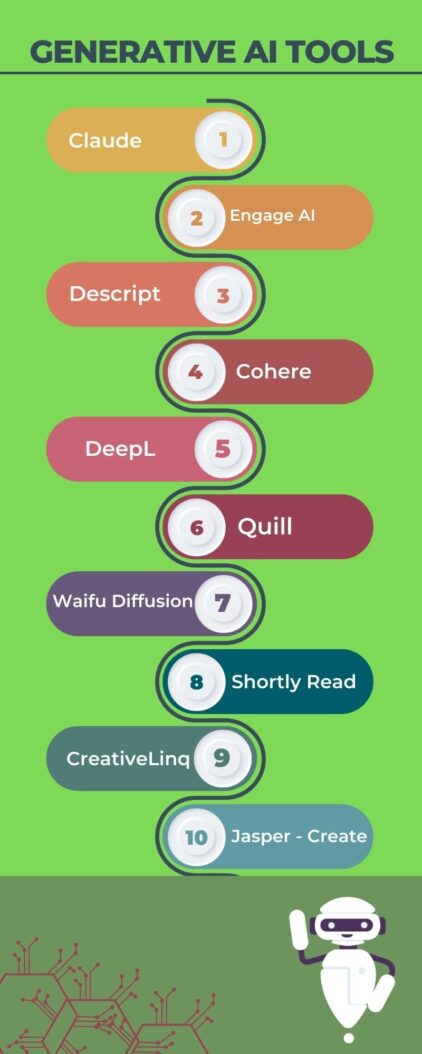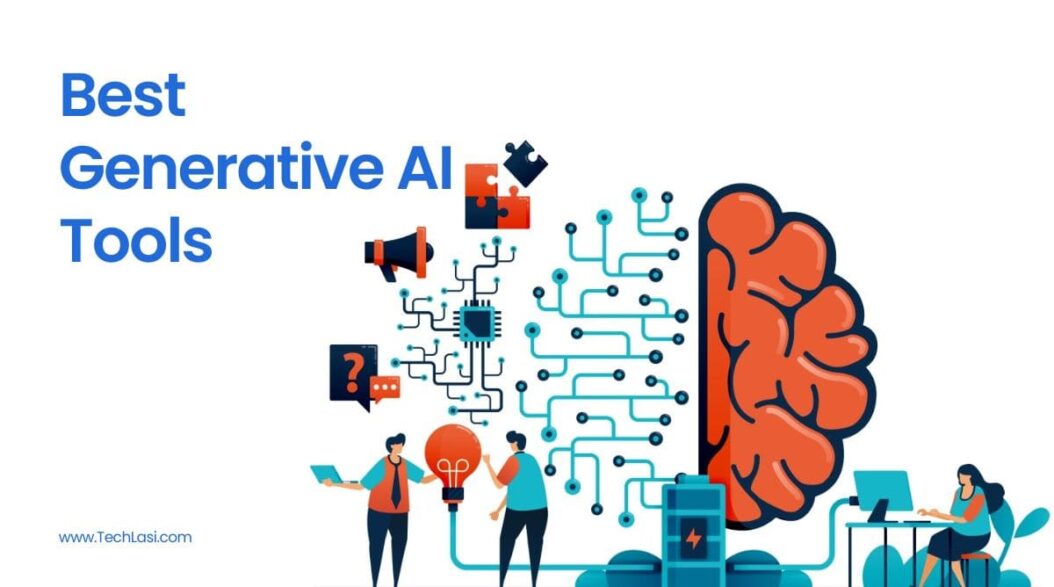Generative AI tools utilize artificial intelligence to generate new content, art, code, and more based on the data they’re trained on. They have seen rapid advancement in recent years thanks to innovations in deep learning. These tools offer creative professionals, developers, artists, and hobbyists new ways to quickly produce high quality outputs.
What are Generative AI tools
Generative AI tools are a category of artificial intelligence systems that use machine learning models to generate brand new content and assets without direct human input. The key aspect that makes these tools “generative” is that they don’t simply analyze input data, they actively build and construct new outputs using complex algorithms.
Common types of outputs include:
- Text content and creative writing
- Images, illustrations and art
- 3D models and objects
- Computer code and programs
- Music and other audio
- Human like conversational agents
These tools learn patterns from vast datasets during the training process to statistically build an understanding of relationships between concepts. They can then extrapolate and make inferences to best predict what new outputs would logically fit requested prompts and parameters set by the user.
Why Generative AI is such a game changer?
There are a few key reasons why generative AI represents such a paradigm shift compared to earlier AI technologies:
- The outputs are completely original rather than reliant on remixing existing content. This enables far more creativity and innovation.
- They require less explicit programming input from developers. The models effectively “learn” to generate intelligently themselves.
- The rate at which high quality, usable outputs can be produced is exponentially faster.
- Costs are reduced since less human effort and intervention is necessary. Machine learning handles the heavy lifting.
Put simply, generative AI removes many traditional constraints around developing content and technology. Things that used to be complex, expensive, or time consuming can now happen almost instantly.
How Generative AI tools actually work?
The core technology powering most generative AI tools involves two connected machine learning methods:
Neural networks
Neural networks loosely mimic how the human brain works to interpret and analyze information. They contain interconnected nodes that transmit signals between one another, strengthening important connections and weakening unnecessary ones. This architecture gives neural networks the ability to detect patterns and features in vast datasets. The more data they process, the more accurate they become at recognizing relationships.
Generative adversarial networks (GANs)
GANs consist of paired neural networks one generative and one discriminative. The generative network creates new data instances (such as images) by learning from real example data, while the discriminative network attempts to detect the difference between the generated data and real data. The two networks compete against each other in an adversarial game during training until the generative network is producing highly realistic outputs that can pass the discrimination test. Combined together, these core methods enable generative AI models to generate shockingly human like content.
Benefits and use cases
There are a wide range of potential benefits unleashed by integrating generative AI tools into creative and technical workflows:
- Reduced costs Dramatically speed up content and asset creation vs traditional methods.
- Efficiency Automate repetitive, low value parts of the workflow. Focus human effort on high judgement tasks.
- Consistency enerate assets and copy tailor made to consistent brand guidelines.
- Innovation Explore more ideas; higher likelihood of standout pieces.
- Personalization Create at scale with custom one to one messaging.
And those are just a few examples. Applications span things like social media content, blogs, videos, voice assistants, digital avatars, product listings, translators, customer support automation, and essentially every other aspect of marketing and technology.
Top 10 best generative AI tools available today
There have been incredible innovations in generative AI capabilities in recent years from both leading tech companies and AI startups. After testing numerous options hands on, here is my list of the current top 10 best generative AI tools:

1. Anthropic – Claude
Anthropic Claude is my #1 pick thanks to its exceptionally coherent, thoughtful and nuanced writing ability. Unlike rival tools, its unique Constitutional AI safety approach allows it to reliably stay helpful, harmless, and honest. Perfect for effortlessly drafting emails, articles, speeches, and more in a human voice.
2. Jasper – Writers
Jasper specializes in creating engaging long form written content with long term context and personality integrated straight into the AI model itself. A superb choice for blogs, stories, books, guides, and other projects needing a consistent narrative voice and high quality writing.
3. Descript Podcast Studio
An end to end podcast creation platform powered by AI, Descript Podcast Studio makes editing audio as easy as editing text documents. Auto transcribes recordings, lets you rewrite words for seamless edits, suggests high quality edits, and even creates entirely AI generated voices including multiple character voices. Perfect for all your podcasting needs to save huge amounts of time.
4. Jasper – Create
Another top offering from Jasper, this time focused on graphical content generation. Submit text prompts about what you want to create, and this AI artist will generate stunning original images, digital paintings, logos, graphics, and more in an ever growing variety of art styles. An amazing tool for illustrators, marketers, and businesses wanting custom visual assets fast.
5. Cohere
Cohere makes natural language generation accessible for everyone. Submit a few words or sentences to instantly receive AI generated content continuations matching whatever tone and style you need. Helpful for quickly brainstorming ideas, expanding outlines, enhancing drafts, answering queries, and more. Seamlessly bolsters your own writing skills.
6. DeepL
The translation experts at DeepL have developed an extremely advanced AI translator that achieves far better quality than any free alternative. Retains meaning context better, follows correct grammar rules, and captures nuance. Quickly translate documents, websites, messages, and more into a huge variety of language pairings with responsive human like phrasing.
7. Quill
Quill by Anthropic generates intelligent long form explanatory content tailored to the reader’s understanding. Define a topic along with key points you want covered, customize the tone from casual to formal, and Quill returns multiple detailed paragraph elaborations to insert into articles, emails, guides, and other writing. Augments your workflow.
8. Waifu Diffusion
On the more experimental end, Waifu Diffusion by Plasticity pushes the boundaries of AI generated anime character art. Text to image diffusion models create incredible hand drawn anime girl portraits from written physical and costume details. An original way for anime fans and artists to instantly bring their imagination to life.
9.Shortly Read
Shortly Read does exactly what the name says it summarizes long pieces of text into concise abridgements while retaining key information. Customize summary length from 5% to 35% of the original. Helpful for both quickly understanding what documents, articles, or pages are about before deciding to read further as well as distilling explanations down to their most vital takeaways.
10. CreativeLinq
Last on our list is relative newcomer CreativeLinq which specializes in AI digital marketing content generation from Facebook/Google ads to product descriptions and more. Marketers describe what assets or copy they need and this creative assistant delivers tailored, brand aligned results in seconds designed to grab attention and convert.
What does the future hold for generative AI?
Given the immense progress over the past few years alone, it’s hard to even imagine how advanced generative AI systems will become in the near future as research continues. But a few upcoming innovations give us hints:
More specialization
While today’s tools already exhibit impressively broad capabilities, we will see more and more models focused on mastering one specific creative domain really well from coding to music to 3D worldbuilding and beyond.
Multi-modal outputs
So far most systems center on single output types like text, images, or audio. Combining these together into multi modal outputs will open more lifelike applications. For example: Generate a cartoon adventure story complete with dialogue voice acting and animated visuals.
Better reasoning
Pure machine learning works well for pattern recognition but struggles with complex logical reasoning. By integrating rule based programming and causal models, future AI could demonstrate far stronger general intelligence and common sense. Suffice to say, generative AI technology remains in its infancy with room to mature in wonderfully surprising new directions we can scarcely predict today.
Conclusion
After digging into the top offerings available right now in 2023, generative AI has clearly demonstrated the huge potential it offers to augment and enhance human creativity along with making workflows vastly more efficient. These systems keep advancing at a breakneck pace too so expect the landscape to look different again in merely months as new state of the art solutions emerge. Any artists, marketers, writers, coders, podcasters and more doing repetitive creation tasks stand to benefit greatly from incorporating AI generation into their process, if not already. I highly recommend giving at least a few of the excellent tools on this list above a try tailored to your needs. When utilized properly and ethically, generative AI promises to make once unimaginably complex feats of creation accessible with just a few clicks, allowing us humans to focus our energy on higher reasoning judgement tasks better left to our remarkable biological cognitive capabilities. The futures looking bright!
FAQ
What is DALL-E?
DALL-E is an AI system created by OpenAI that generates realistic images and digital art from any text description. It demonstrates very impressive creativity and understanding of nuanced image details. However, it currently has very limited availability via a waitlist for new users.
Is there a free alternative to DALL-E for image generation?
Yes, Stable Diffusion is an impressive open source AI generator rivaling DALL-E in capabilities that anyone can freely access and run on their own high end hardware. There are also online services like DreamStudio letting more casual users leverage Stable Diffusion via app interfaces rather than needing to self host the algorithms locally.
Can these AI tools replace real human writers and artists?
At present, generative AI still works best when human creators direct it via thoughtful prompts and guidance. The AI handles rote production tasks rapidly, while people focus on high level coordination and quality checks. So it enhances more than replaces humans thus far. But capabilities are continually advancing toward further autonomy.
What risks and downsides come with generative AI tools?
Despite strict safeguards in place, no generative AI is yet perfect. There remains potential for issues like biased outputs, factually incorrect content, harmful instructions generated from overly vague prompts, and copyright/trademark infringement. Close human monitoring is still crucial to catch any problems not aligned with intended uses.
How can I get started leveraging these AI content creation tools today?
Many top services offer generous free trials and usage tiers to make getting started accessible for anyone. Identify your highest pain points around content creation workflows and research solutions on this list specifically targeting improvements there. Most provide intuitive prompts and UIs usable even for total beginners.
- What is One Challenge in Ensuring Fairness in Generative AI: The Hidden Bias Problem - August 15, 2025
- How Small Language Models Are the Future of Agentic AI - August 15, 2025
- What Are the Four Core Characteristics of an AI Agent? - August 15, 2025

